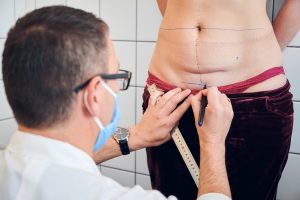Introduction
Abdominoplasty, commonly known as a tummy tuck, is a transformative cosmetic procedure that helps individuals achieve a firmer, flatter abdomen. While it can be an excellent solution for many, it’s crucial to understand who the ideal candidate for abdominoplasty is and why. In this article, we explore the qualifications for this procedure, the importance of initial weight loss, the recovery process, and the expected outcomes.
Who is suitable for Abdominoplasty?
The ideal candidate for abdominoplasty typically meets the following criteria:
- Good Overall Health: Candidates should be in good general health, free from medical conditions that could complicate surgery or healing.
- Stable Weight: It is essential that candidates have reached a stable weight before considering a tummy tuck. Significant fluctuations in weight after the procedure can affect the results.
- Excess Abdominal Skin: Ideal candidates have excess skin, either due to significant weight loss, pregnancy, or aging. This excess skin can lead to sagging and loss of abdominal tone.
- Diastasis Recti: Candidates may also have diastasis recti, a separation of the abdominal muscles, which can be corrected during the procedure.
- Realistic Expectations: A crucial aspect of being an ideal candidate is having realistic expectations about what abdominoplasty can achieve. While it can create a flatter and more toned abdomen, it is not a substitute for weight loss or a solution for significant stretch marks.

What is the weight requirement for Abdominoplasty?
Before undergoing a tummy tuck, it’s advisable for individuals to achieve their target weight through a combination of a balanced diet and exercise. Abdominoplasty is not a weight loss procedure; rather, it’s designed to remove excess skin and tighten the abdominal muscles. By losing weight first, candidates can maximize the effectiveness of the procedure and reduce the risk of complications.

How long does it take to heal from Abdominoplasty?
The recovery period following a tummy tuck can vary from person to person but typically includes the following:
- Immediate Post-Op: After surgery, patients will experience swelling, bruising, and discomfort. Pain management and follow-up appointments are crucial during this period.
- First Few Weeks: Patients are advised to rest and avoid strenuous activities. Wearing compression garments is usually recommended to reduce swelling and support the healing process.
- Resuming Activities: Most individuals can return to work and light activities within a few weeks, but vigorous exercise should be avoided for several weeks or as per the surgeon’s instructions.
- Long-Term Recovery: The final results of a tummy tuck can take several months to become fully visible as swelling subsides and the incisions heal.
What Can I expect after Abdominoplasty?
For ideal candidates, abdominoplasty can provide significant benefits, including:
- Flatter and Toned Abdomen: The procedure can eliminate excess skin, tighten the underlying muscles, and create a more toned abdominal appearance.
- Improved Self-Confidence: Achieving a firmer abdomen often leads to increased self-esteem and body confidence.
- Clothing Fit: Patients can enjoy a better fit in clothing and swimsuits, without the need to conceal excess abdominal skin.

Conclusion
Abdominoplasty is a life-changing procedure for those who meet the criteria and understand its limitations. It can help individuals achieve a firmer, more toned abdomen and enhance their overall quality of life. With realistic expectations, initial weight loss, and proper post-operative care, the results can be both remarkable and long-lasting. Consulting with a board-certified plastic surgeon is essential to determine candidacy and plan a safe and effective tummy tuck procedure.
Disclaimer: The content on this blog is intended for general informational purposes only. It is not a substitute for professional medical advice, diagnosis, or treatment. Always consult qualified healthcare providers for personalized advice. Information regarding plastic surgery, dental treatment, hair transplant, and other medical procedures is educational and not a guarantee of results. We do not assume liability for actions taken based on blog content. Medical knowledge evolves; verify information and consult professionals. External links do not imply endorsement. By using this blog, you agree to these terms.










